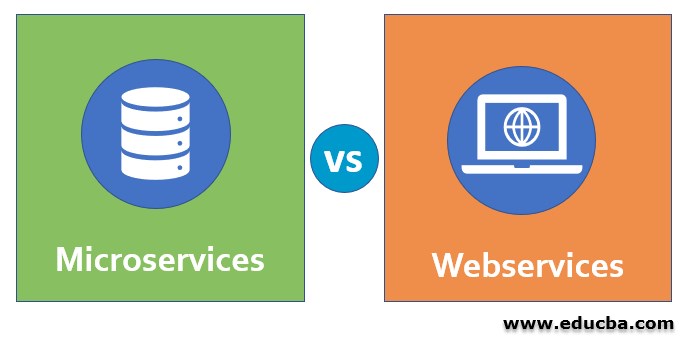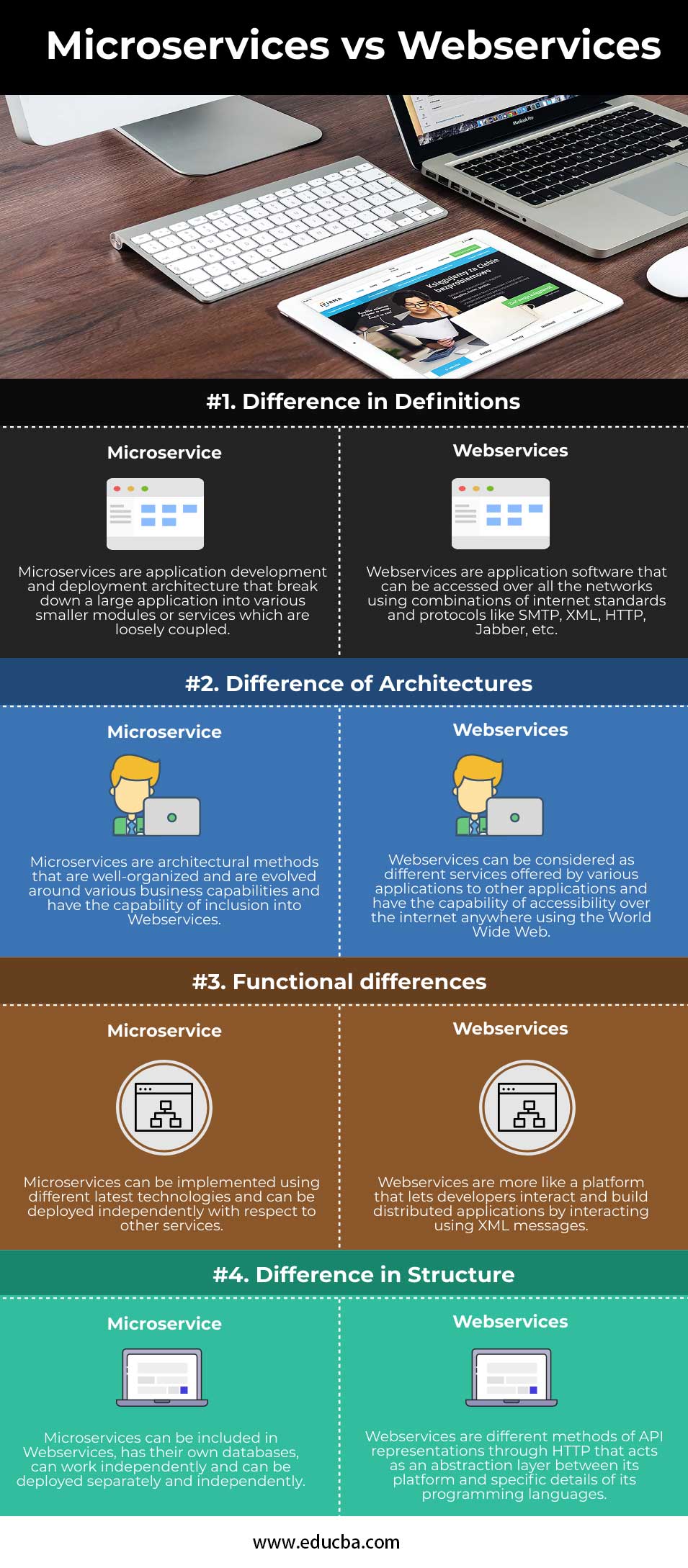Difference Between Microservices vs Webservices
Finding a better way to build a system is always challenging. A lot of the latest technologies are being adopted for it. All the companies try to make their customers happy by adopting the latest technologies and creating IT systems using the latest technologies. Microservice was developed from real-world use-cases. Microservices are independent and small services that talk with each other and all together work as a single application. Microservices help businesses to adopt the latest technologies more effectively than before quickly. On the other hand, Webservices are the services available on the internet and are developed using high-level internet technologies. In this topic, we are going to learn about Microservices vs Webservices.
Head to Head Comparison Between Microservices vs Webservices (Infographics)
Below are the top differences between Microservices vs Webservices
Key differences of Microservices vs Webservices
Let us discuss some of the major key differences between Microservices vs webservices
Both Microservices and Websites are different ways of software product definitions that break large applications into small and manageable services that can interact with each other. The microservice architecture includes breaking a large application down into smaller components, and these smaller components can independently work and, they all together, work as an application. Microservices communicate with each other using an interface.
On the other hand, Webservices are also like Microservices. Webservices are also smaller services that can communicate with each other and work together as a big application, but all the Webservice activities happen only over a network that too in a well-defined format. Webservices communicate with others using a well-defined interface and languages like XML.
Microservices are built to adjust to the breakdowns and failures of large applications. Each module of Microservices has unique functionality and interacts with each other using different APIs. There can be many failures as multiple services are interacting together, but the failure of single modules would not affect the overall functioning of the large application. Webservices are not restricted to a single programming language or operating system. Webservices act as connection technology and help connect all services to Service Oriented Architecture or SOA.
Major differences of Microservices vs Webservices are as follows:
Definition
- Microservices and Webservices are different software development architectures that easily help develop and deploy the software application.
- Even though Microservices and Webservices are almost similar in many aspects, the development style is very different in both.
- Microservices are application development architectures that help structure an application as a set of loosely coupled modules.
- Microservices is considered as a light Service Oriented Architecture or SOA.
- On the other hand, Websites are interfaces with network accessibility for the functionality of the application that helps expose the application functionality of one application to others.
- Webservices are applications that are accessible over networks using combinations of various protocols like XML, HTTP, Jabber, SMTP, etc.
Architecture
- Microservices are also called Microservice Architecture.
- Microservices are different types of architectural styles organized mainly around business priorities and capabilities.
- Microservices are approaches for modularizing applications where large applications are broken down into small services or modules that help to implement, understand, and further develop the application.
- On the other hand, Webservices has a new architectural model of applications and are light Service Oriented Architecture or SOA.
- It is an interoperating architecture.
- It can identify different elements of Webservices networks and ensure the smooth interoperability of all the Webservices.
Structure
- Microservice is considered as an architectural style that has evolved around various business capabilities.
- Microservices can be included in Webservices.
- Also, Microservices have independent functionalities that are service implemented.
- Microservices can have their own databases and have the ability of independent deployment.
- On the other hand, websites act as abstraction layers between the platform and specific details of its programming languages, including the way of invoking the application code.
- Webservices are also different ways of representations of APIs through HTTP.
- Webservices are also considered as services that are offered by different applications to other applications and are accessible anywhere using the World Wide Web.
Function
- Microservices are collections of self-sustained, small, and independent services or software built to solve big problems for various systems.
- The division of the system facilitates the development, implementation, and understanding of the application software into smaller modules or services.
- As there are different Microservices for an application, each Microservice can work independently. Each one can be tested and deployed separately, letting the developer work on them independently.
- On the other hand, Webservices helps in the integration of various applications more easily and rapidly than before.
- It also facilitates communication between its own small applications using internet standards and protocols, which further reduces the cost of various e-businesses.
Microservices vs Webservices Comparison Table
Let’s see some more differences between Microservices vs Webservices through a comparison table for clear understanding:
| Comparison | Microservices | Webservices |
| Difference in Definitions | Microservices are application development and deployment architecture that break down a large application into various smaller modules or services which are loosely coupled. | Webservices are application software that can be accessed over all the networks using combinations of internet standards and protocols like SMTP, XML, HTTP, Jabber, etc. |
| Difference of Architectures | Microservices are architectural methods that are well-organized and are evolved around various business capabilities, and have the capability of inclusion into Webservices. | Webservices can be considered as different services offered by various applications to other applications and have the capability of accessibility over the internet anywhere using the World Wide Web. |
| Functional differences | Microservices can be implemented using different latest technologies and can be deployed independently with respect to other services. | Webservices are more like a platform that lets developers interact and build distributed applications by interacting using XML messages. |
| Difference in Structure | Microservices can be included in Webservices, has their own databases, can work independently and can be deployed separately and independently. | Webservices are different methods of API representations through HTTP that acts as an abstraction layer between its platform and specific details of its programming languages. |
Conclusion
Both Webservices and Microservices architectures break large applications into smaller services. Microservices and Webservices have their own advantages and disadvantages. Choosing between Microservices and Webservices is completely up to the developer or the businesses. Webservices have the advantage of accessibility over the internet.
Recommended Articles
This is a guide to Microservices vs Webservices. Here we discuss the Microservices vs Webservices key differences with infographics and comparison table. You may also have a look at the following articles to learn more –




